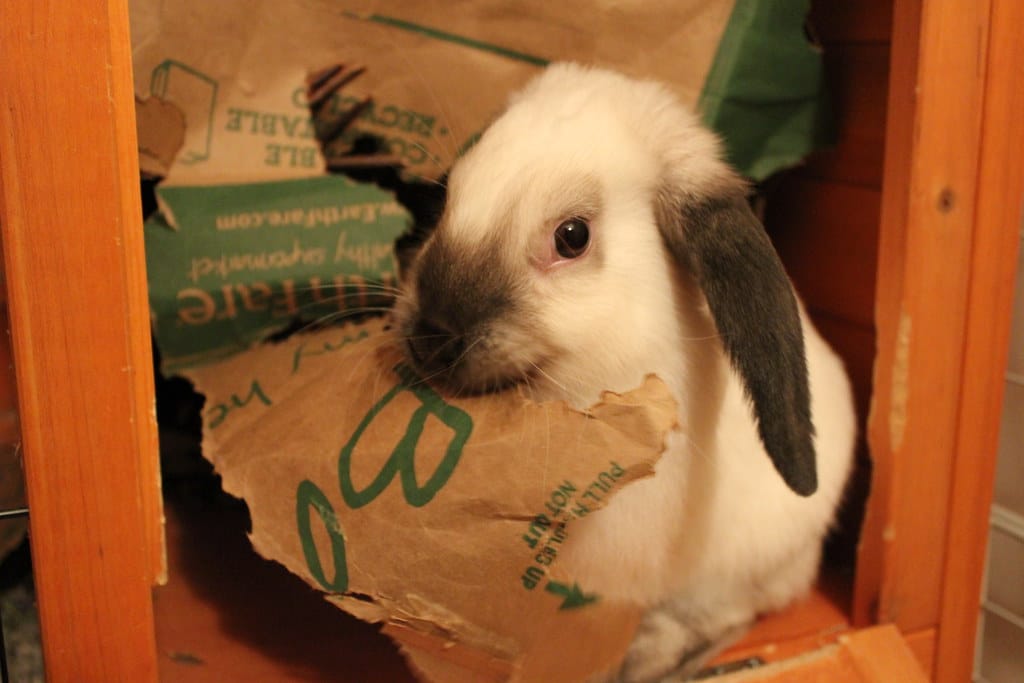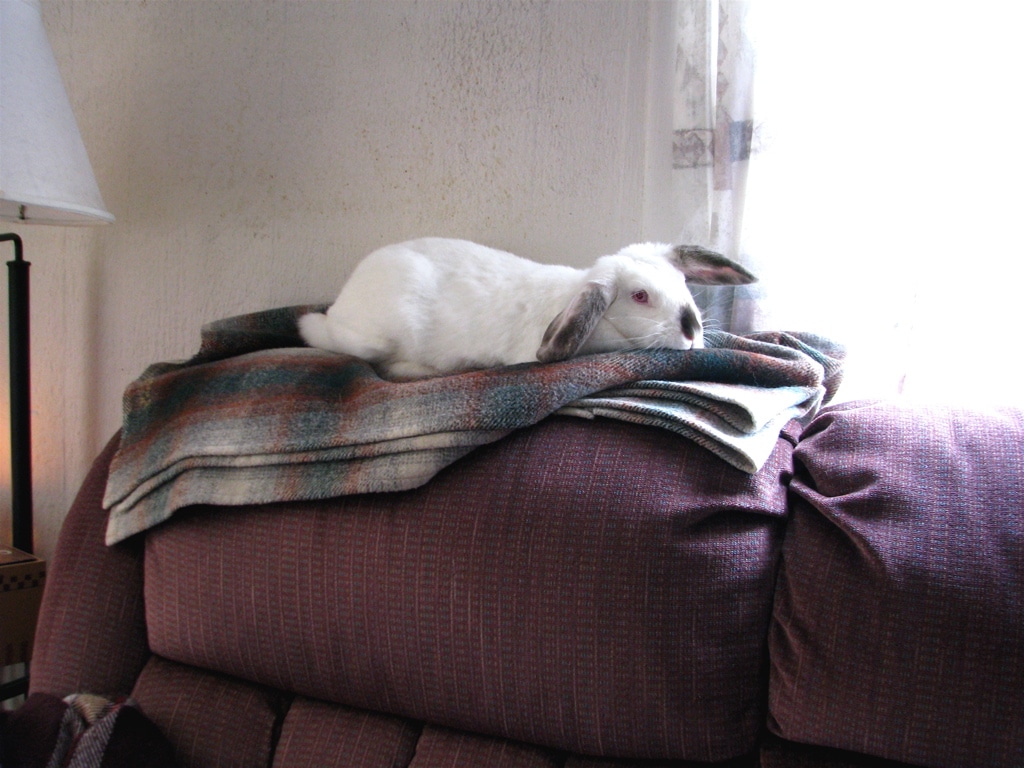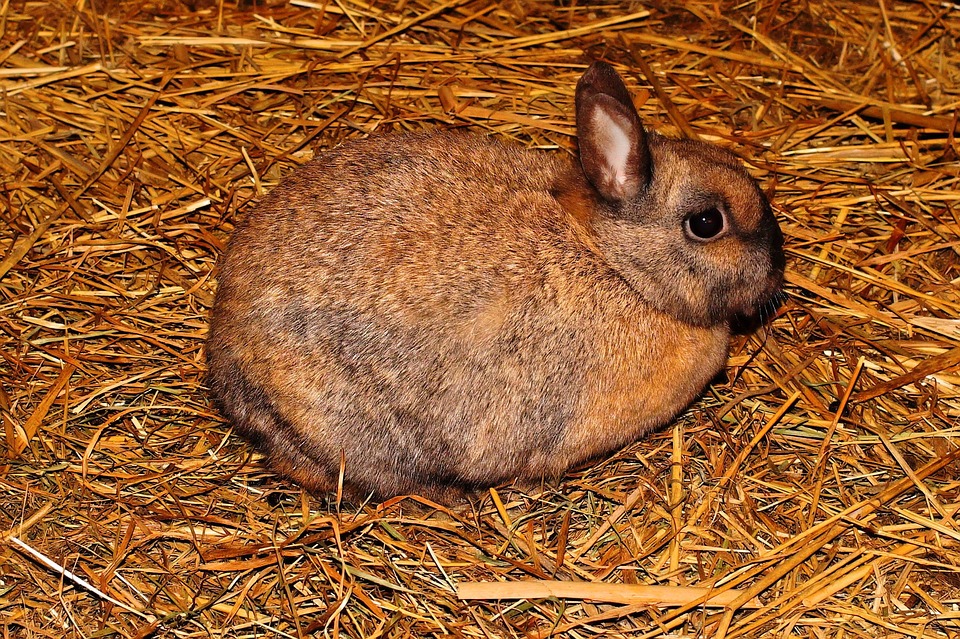What can you line a rabbit hutch with? Quite a few things, actually. But before you do, there are some considerations to keep in mind.
Why Line Your Hutch Floor?
Do you need to line the floor of your rabbit enclosure? Maybe, maybe not.
Home & Roost rabbit hutches come with a solid plywood floor treated with a rabbit safe wood treatment. But not all rabbit enclosures do. Many enclosures, in fact, have a wire bottom, which can harm your bunny’s feet.

Some cages also have a solid plastic bottom. These can be slippery, especially when wet.
A good lining material can provide many different types of protection. But there are other factors to think about, as well.
Foot Protection
Wire floors are very hard on delicate rabbit feet. In fact, wire floors are a main culprit in Ulcerative Pododermatitis (also called “bumblefoot” or “sore hock”).
Ulcerative pododermatitis is a bacterial infection of the skin. It happens when bacteria on the floor of the hutch get into the skin of the back feet and hocks. The bacteria enter the skin through scratches and pressure sores caused by wire flooring.
This alone is painful for your rabbit. However the infection can lead to a variety of serious health problems, including joint swelling, abscesses, bone marrow infections, and more.
If your rabbit cage has a wire floor, the right lining material can make all the difference for your rabbit’s feet.
Hygiene
Many rabbits use a litter box. However, plenty of rabbits don’t. Whatever you choose to line your rabbit cage with, it needs to be absorbent and either washable or easy to dispose of.
By the way, if your rabbit isn’t litter box trained, it’s not difficult to do. Check out our article on litter training rabbits for more information.
Chew Safety
Rabbits are inveterate chewers. Their teeth never stop growing, and chewing on anything and everything helps them to keep those teeth in check.
Everything in your rabbit’s environment, including floors and bedding, needs to be rabbit safe. That means non-toxic and unlikely to break into small pieces that could cause a perforation or obstruction.
Weather
Bedding and flooring can provide your rabbit with additional protection from the weather. In hot climates, avoid using blankets or towels.
Seven Ways to Line a Rabbit Hutch
The good news is, there are numerous materials that you can use to line your rabbit cage. You may even have some of these at home right now.
Paper
Yes, you can use paper to line your rabbit cage. Brown paper bags, in particular, make a good liner. Newspaper, whether shredded or laid flat, can also work. You can use paper as is or shred it. Your rabbit may also enjoy shredding it themselves.

It’s important, however, to avoid paper that has any sort of coating or finish, as these can make your rabbit sick.
Commercial paper bedding is another option that’s effective, eco-friendly, and generally inexpensive.
Pros
- Easy to find
- Inexpensive
- Eco-friendly
- Chewable
- Disposable
- Soft
- Can provide entertainment as well as flooring
- Shredded paper can also insulate
Cons
- Absorbent, so you’ll have to change it often
Wood Bedding
Wood shavings are another time-honoured rabbit bedding material. However, not all wood is suitable.

Avoid cedar wood products. Cedar is a popular material for its colour, and for its attractive scent. Unfortunately, the scent comes from a volatile oil which has been shown to cause serious respiratory and liver problems in small animals.
The aromatic oil in cedar can also cause severe skin problems for your rabbit.
Pine shavings are safe for the respiratory system and liver, though some animals have allergies and skin sensitivities to pine. Kiln-drying reduces the compounds that cause animals problems, however. So if you choose wood bedding, choose kiln-dried wood.
Aspen is a non-aromatic hardwood. Although it’s not as good at controlling odour as aromatic woods, it’s considerably safer.
Wood bedding comes in both shavings and pellet form. These may not be ideal if your rabbit cage has a wire mesh floor.
Pros
- Soft
- Insulating
- Disposable
Cons
- Some types of wood can cause health problems for your pet
- Absorbent. Change it often.
- May fall through a wire mesh floor
Linoleum (Lino, Marmoleum)
Lino might not be the first rabbit hutch flooring material that comes to mind, but it can be quite a good one.
Linoleum is solid. It’s generally easy to wipe clean. Also, lino lasts a long time and is quite cost effective. If that’s not enough, many types of linoleum are made primarily from natural materials such as linseed oil, cork, wood flour, tree resins, and limestone powder.
In addition to being very functional, many varieties are both non-toxic and sustainably produced.
You can also find pet safe faux laminate flooring to fulfil the same function.
Pros
- Long lasting
- Sustainable
- Wipes clean
- Many varieties are non-toxic
Cons
- You may have to search for real marmoleum
Woven Mat
Woven mats made from natural materials like grass or bullrush can do double duty as rabbit cage flooring and entertainment.
These mats are thick and solid enough to protect both wooden hutch floors and rabbit feet. As a bonus, they’re chew-safe. In fact, they’re made to stand up to scratching and chewing from your rabbit.
You may have to replace the mats from time to time, but not before your rabbit has had a whole lot of fun, first.
Pros
- Double duty as flooring and entertainment
- Rabbit safe and non-toxic
- Durable
- Eco-friendly
Cons
- These can be a bit on the pricey side
Fleece
Fleece fabric can also make a good liner for your rabbit cage. It’s washable, durable, and inexpensive. You can buy pre-made fleece pet blankets or make your own (it’s literally just a matter of cutting the fabric).

If your rabbit cage has a wire floor, a single layer of fleece might not be enough to protect bunny feet. In this case, you might consider making a two-layer blanket for the floor.
Keep your eyes open, though. Your rabbit may like the fleece so much it will “take up the carpets” and use it for bunny bedding instead.
Finally, this is an eco-friendly option. It’s both reusable and sustainable. In fact, many types of fleece are made from recycled soda bottles.
Pros
- Washable
- Durable
- Sustainable
- Inexpensive
- Non-toxic
- Insulating
Cons
- Fleece is a synthetic fabric and repels, rather than absorbs liquid
- May provide too much warmth in hot climates
Hay or Straw
We all know that rabbits need to eat plenty of hay. Many of us have probably struggled with getting ours to do just that. There are tricks to encourage your rabbit to eat more hay, and one of those tricks is having plenty of it about.
Hay isn’t just for breakfast, though. Hay can also provide insulation for your rabbit, act as bedding, and, yes, it can be flooring, too.

If you’re lining your rabbit enclosure with hay, you can use feeding hay. Alternately, you could use straw or dust-extracted bedding hay.
Why dust-extracted? Well, while feeding hay is fresh and meant to be eaten, bedding hay is dry. And that produces dust, which can irritate your rabbits’ eyes and lungs. Dust extraction removes the dust so that it’s better for your bunnies.
Hay and straw are ideal bedding materials. First and foremostly, because it’s natural for your bunny to be surrounded by them. These materials are completely bunny safe. In fact, your rabbits should be eating it.
Hay and straw are also insulating. They do absorb liquid waste, however, so to avoid mould and mildew, you’ll have to change hay bedding often.
Pros
- Edible
- Insulating
- Good for nesting
- Natural
- Eco-friendly
- Inexpensive
Cons
- Needs to be changed often
Cardboard
Recycling your cardboard is great. But it’s even better when you can reuse it. You can break down cardboard boxes and envelopes to make a soft, solid, chewable liner for the floor of your rabbit hutch.
Just make sure to remove any staples, tape, glue, or labels, first.
Pros
- Inexpensive
- Easy to find
- Non-toxic
- Chewable
- Absorbent
- Eco-friendly
Cons
Because cardboard is absorbent, make sure to remove it when it becomes soiled. How often will depend on whether your rabbits are litter box trained.
What’s in Your Rabbit Hutch?
For some types of rabbit enclosures, a floor liner is unnecessary. If your hutch or cage has a pet-safe solid, non-slip floor (like our hutches do) then you’re set.
But if your cage or enclosure has a wire or plastic floor, then you’ll need to take measures to protect your bunnies’ feet.
Cardboard, hay, and paper make excellent flooring for a cage or hutch. You probably already have some in your home right now. Wood bedding, marmoleum, and fleece work well, too.
What’s your favorite flooring for your rabbit hutch or cage? Tell us about it!

















Excellent article, really informative and helpful
Can you use shell grit?